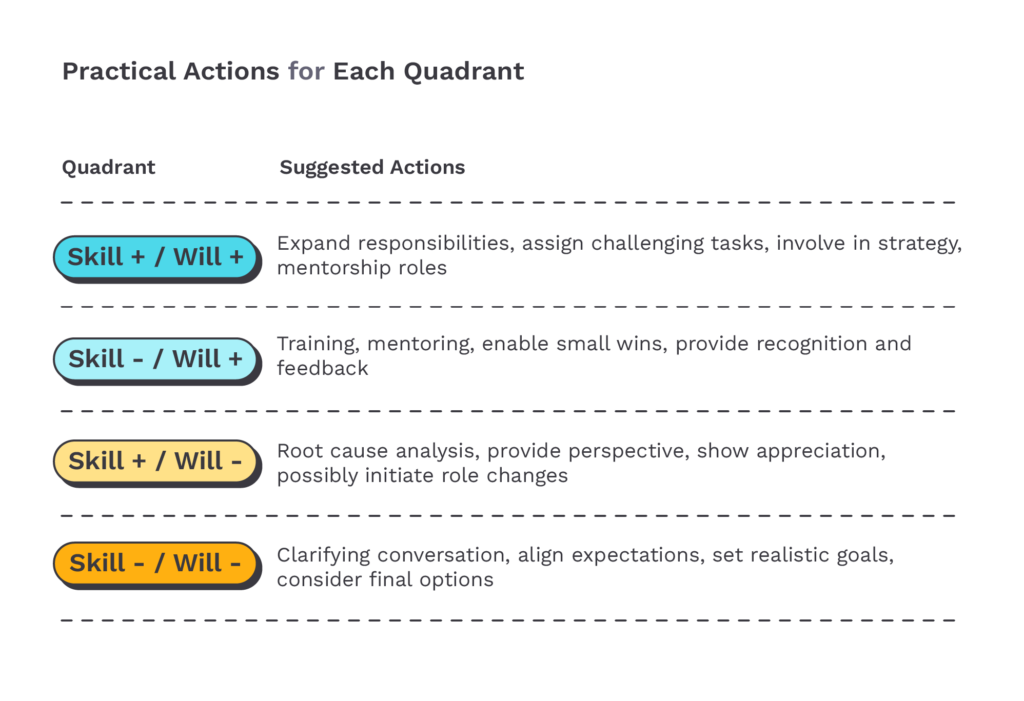In a constantly evolving work environment where talent retention and individual development are becoming increasingly important, leaders need tools that are simple to use—and actually helpful in daily work. The Skill-Will Matrix is one of them. It helps leaders assess their team members more effectively and support them in a targeted way. In this article, we explain how the matrix works, how it can be applied in practice—and why it’s not a rigid evaluation tool but a starting point for real dialogue.
What Is the Skill-Will Matrix?
The Skill-Will Matrix (also known as the Competence-Motivation Matrix) is based on a simple but effective idea: a person’s contribution depends not only on their ability (skill) but also on their motivation (will). Those who have both tend to perform well—those who lack one of the two need targeted support.
The matrix divides team members into four categories:
- High Skill, High Will: These employees are independent, capable, and motivated. They don’t need close supervision but room to grow.
- High Skill, Low Will: There’s untapped potential here. Reasons for low motivation may include being over- or under-challenged, lack of recognition, or personal issues.
- Low Skill, Low Will: This combination requires special attention. It’s important to assess whether the person is in the right role—and what development opportunities might exist.
- Low Skill, High Will: These employees are eager to learn but lack the necessary skills. They benefit from coaching, structured guidance, and hands-on training to develop their abilities.
Individual Fit: Helps in placing employees in roles where they can perform at their best while remaining motivated and engaged.

What Kind of Motivation Are We Talking About?
Motivation is not one-dimensional. The Skill-Will Matrix becomes even more powerful when we understand why someone is motivated—or demotivated. We can broadly distinguish between two types:
- Intrinsic motivation: comes from within—joy in the task itself, interest in the subject, or a desire for personal growth. It is especially sustainable and powerful.
- Extrinsic motivation: based on external rewards such as salary, recognition, status, or social pressure. It can be effective in the short term, but often doesn’t last.
For leaders, this means: Understanding what kind of motivation is at play isn’t just theory—it makes a real difference when you’re trying to support someone effectively. It’s worth creating work environments that foster intrinsic motivation—through meaningful tasks, autonomy, and honest feedback.
Questions to explore:
- What drives this person?
- What energizes them?
- What requires a lot of effort or feels draining?
The Matrix as a Leadership Tool
The Skill-Will Matrix is not a static evaluation tool but a dynamic framework for leadership. It helps initiate reflection, structure conversations, and define tailored development actions. It is especially useful in performance reviews, onboarding sessions, or goal-setting discussions. Rather than focusing solely on past performance, it offers a shared foundation for future-oriented conversations.
Quick guide for using it in conversations:
- Start with your own assessment (skill/will)
- Ask the employee for their self-perception
- Reflect on discrepancies together
- Define concrete actions and next steps
- Follow up regularly and adjust as needed
Sample reflection questions for leaders:
- How do I currently assess the skills and motivation of my team members?
- What has changed over the past few months?
- Where are the strengths? Where is there room for growth?
Practical Actions Based on the Skill-Will Matrix

Avoiding Common Pitfalls
Like any tool, the Skill-Will Matrix can lead to oversimplification if misused. It should not be seen as a label but as a starting point for meaningful conversations. Three common mistakes to avoid:
- Jumping to conclusions: Low motivation in a moment doesn’t mean someone isn’t willing—maybe the context isn’t right.
- Equating “skill” with degrees or years of experience: Technical skills may be visible, but social and methodological skills are just as crucial.
- Underestimating quiet team members: Motivation doesn’t always show up in loud or visible ways—engagement can be subtle.
Strengths and Limitations of the Matrix
The matrix is a starting point, not a label. It thrives on dialogue, openness, and a shared commitment to development. Because both skill and motivation are dynamic, it’s worth revisiting regularly—together with your team.
One key strength of the Skill-Will Matrix is its simplicity. It provides leaders with a shared language to reflect on their team dynamics, even without extensive HR training or diagnostic tools. It’s quick to apply, and the logic behind it is easy to communicate.
However, that simplicity also comes with a limitation: the matrix captures just two dimensions. It doesn’t account for external factors like organizational change, psychological safety, or team climate—all of which can influence performance and motivation.
That’s why the matrix should never be used in isolation or as a strict categorization tool. It works best as a conversation starter—paired with curiosity, experience, and a genuine interest in people’s development.
From Matrix to Action: Everyday Application
Example from real life: Let’s say you’re working with a junior team member who always volunteers for new tasks, asks questions, and shows real energy—but often misses key details. Using the matrix, you’d place them in the “Low Skill, High Will” quadrant. That’s your cue: support them with mentoring, give space to learn, and celebrate small wins. Over time, you’ll likely see both their skill and confidence grow.
To truly benefit from the Skill-Will Matrix, it must become part of everyday leadership. This means not only using it in formal reviews, but also integrating it into weekly check-ins, project planning, or team retrospectives. Over time, leaders can learn to spot shifts in motivation and skill development early—and respond proactively.
Team-wide reflection tip: Try using the matrix in a team workshop to gather insights collaboratively. Let each team member place themselves within the matrix (anonymously or openly), and use the discussion to uncover blind spots, shared challenges, or development needs. This fosters ownership and transparency.
Leadership habit: Revisit your team’s positioning at regular intervals—such as quarterly—to track development, adapt support, and identify emerging patterns. This rhythm keeps leadership close to the team’s actual needs.
Putting It into Practice
Digital tools can support structured assessments—such as through skill profiles, self-evaluations, or continuous feedback loops. They help make subjective impressions more visible and comparable over time. This can be especially useful when team structures are complex, hybrid, or constantly evolving.
By regularly collecting input and tracking shifts in skill and motivation, leaders can make more informed decisions about team composition, development priorities, or project assignments. These insights can also support employee conversations with data, without replacing the human judgment behind them.
However, tools alone aren’t enough. One thing stays the same: real conversations matter more than any framework. Applying the matrix effectively requires openness, curiosity, and a culture of trust—not just structured input, but thoughtful follow-up.
Further Resources
If you want to dive deeper into feedback culture, development conversations, and how leadership tools like the Skill-Will Matrix work in real life, check out our article “Team Feedback as a Growth Lever”. Our Talent Management Blog Series explores the strategic foundations, practical steps, and best practices for developing potential across organizations.
If you’re looking for additional expert insights, the following resources are highly recommended:
Employee Motivation – News and Insights (Haufe) – A comprehensive overview offering practical approaches, background knowledge, and strategies for fostering motivation in organizations.
Employee Motivation: Impact, Relevance and Barriers (WPGS) – A well-researched article highlighting the growing importance of motivation, based on current academic insights.
Conclusion
The Skill-Will Matrix doesn’t give you all the answers—but it helps you ask better questions. It offers a clear and practical way to understand where your team members stand and what kind of support actually makes sense. Used effectively, the Skill-Will Matrix helps leaders move from gut feeling to structured development planning—without losing sight of people’s individuality.
Used regularly and in real conversations, it becomes more than a model. It becomes a mindset of leading with clarity, empathy, and direction—especially in fast-changing environments. Instead of reacting to performance issues or motivation dips too late, leaders can proactively shape development paths and maintain momentum.
This doesn’t require huge programs or extra tools—just a willingness to pause, reflect, and listen. The matrix creates a common language that helps teams talk about what really matters: capabilities, energy, and how both can grow together.
No tool replaces leadership. But this one helps you stay close to your team and focus on what matters: developing people with purpose—and creating a work culture where both motivation and competence are seen, valued, and supported.
👉 Want more insights like this? Follow us on LinkedIn for fresh perspectives on leadership, team development, and the future of work.

